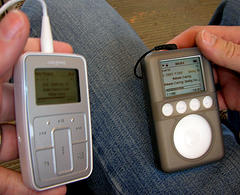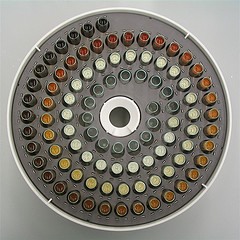December 12th, 2008 by Kevin Lindstrom | No Comments »
Interested in what’s going on at Google? There are a number of ways of doing this. Going to Google Labs will show you some of their cool new technologies.
What else is going on at Google? Searching the ACM Digital Library for Google in the Affiliations field retrieves 359 papers. The most recent being Programming the Intel 80-core network-on-a-chip terascale processor. A paper presented at the of the 2008 ACM/IEEE Conference on Supercomputing held in Austin, Texas.
Another good database to look at is Compendex. Repeating the same affiliation search in Compendex retrieves 278 papers. The most recent article in Compendex is A New Baseline for Image Annotation published in Springer Lecture Notes in Computer Science, volume 5304, pages 316-329, 2008.
Okay. Let’s look at how Google protects its intellectual property. A search of the Google Patents database for Google in the assignee name field retrieves 100 patents/patent applications with the most recent US patent 7,352,833 Method and System for Temporal Autocorrelation Filtering being published on May 8, 2008.
Repeating the same search in Espacenet retrieves over 1675 patents/patent applications with most recent patent/patent application US 20080301093 A1 Determining Search Query Statistical Data for an Advertising Campaign Based on User-Selected Criteria published on December 4, 2008.
Okay, here’s the challenge. Use Google Scholar find the most up-to-date recent articles, patents/patent applications written by researchers at Google. Let me know what you find and how easy it was.
Moral of the story. There is something to be said for databases such as Compendex, Web of Science and Scifinder Scholar that index thousands of journals and conference proceedings and have sophisticated search interfaces that allow you – the end user to find exactly what you are looking for.
Submitted by Kevin Lindstrom Kevin Lindstrom Liaison Librarian for Electrical and Computer Engineering, Earth and Ocean Sciences, Chemistry and Chemical Engineering, Materials Engineering, Physics and Astronomy, and Physical Geography.
Posted in Amusing stuff, Atmospheric Science, Chemical and Biological Engineering, Chemistry, Civil Engineering, Earth and Ocean Sciences, General Science, Geography, Main, Materials Engineering, Mathematics, Mechanical Engineering, News, Physics, Science - undegraduate classes, Statistics, Wood Sciences | No Comments »
December 8th, 2008 by Eugene Barsky | No Comments »

An article in the New York Times looks on the pine beetle epidemic in North America – “Bark Beetles Kill Millions of Acres of Trees in West”
Many people in UBC deal with this precise issue. For instance, try a search on a very general multidisciplinary database such as Academic Search Complete here.
For more comprehensive coverage of this topic , try Web of Science or Agricola databases.
** Photo by Stephen Rees
Posted in Main, News, Science - undegraduate classes, Wood Sciences | No Comments »
December 5th, 2008 by Kevin Lindstrom | No Comments »
Impact factors, Journal Citation Reports, the Science Citation Index and its online version the Web of Science are all statistical measures of the importance of journals and of the researchers who publish in them.
There are in fact journals that specialize in bibliometrics – the journal Scientometrics is one such example.
Dr. Jorge Hirsch, a physicist at UC San Diego has taken the “times cited” measure one step further by proposing the h-index “defined as the number of papers with citation number >h, as a useful index to characterize the scientific output of a researcher.”
Does the h index have predictive power? Hirsch, J. E. Department of Physics, University of California at San Diego, La Jolla, CA, USA. Proceedings of the National Academy of Sciences of the United States of America (2007), 104(49), 19193-19198.
Bibliometric measures of individual scientific achievement are of particular interest if they can be used to predict future achievement. Here we report results of an empirical study of the predictive power of the h index compared with other indicators. Our findings indicate that the h index is better than other indicators considered (total citation count, citations per paper, and total paper count) in predicting future scientific achievement. We discuss reasons for the superiority of the h index.
Using the Web of Science database, h-indexes can also be calculated for individual departments . For example, here’s the h-index numbers for a select number of Canadian university electrical engineering departments:
TORONTO 89
UBC 54
MCGILL 53
ALBERTA 51
The folks at Thomson Reutershave put together a short but very information video on impact factors and how to use the Web of Science database to find your own h-index.
Submitted by Kevin Lindstrom Liaison Librarian for the Physical and Appled Sciences, University of British Columbia
Posted in Atmospheric Science, Chemical and Biological Engineering, Chemistry, Civil Engineering, Earth and Ocean Sciences, General Science, Geography, Main, Materials Engineering, Mathematics, Mechanical Engineering, Physics, Science - undegraduate classes, Statistics, Wood Sciences | No Comments »
November 18th, 2008 by Eugene Barsky | No Comments »

An article by Kevin and I has just been published early this week. It is free open access, please feel free to read and forward it to your colleagues:
Barsky E., & Lindstrom K. Podcasting the Sciences: A Practical Overview. Issues in Science and Technology Librarianship, Fall 2008.
Abstract:
University science education has been undergoing great amount of change since the commercialization of the Internet a decade ago. Mobile technologies in science education can encompass more than the proximal teaching and learning environment. Podcasting, for example, allows audio content from user-selected feeds to be automatically downloaded to one’s computer as it becomes available online, and then later transferred to a portable player for the user’s consumption at a convenient time and place. Enjoying a phenomenal growth in mainstream society, podcasting is asynchronous and could be provided at a distance from a classroom. This paper reports a case study from the University of British Columbia that implemented podcasting for physics content. It presents the rationale for, technical details, and step-by-step guide to creating podcasts in the sciences.
** Photo by Josh Bancroft
Posted in General Science, Main, News, Podcasts, Science - undegraduate classes | No Comments »
November 12th, 2008 by Eugene Barsky | No Comments »

A major new global prize celebrating the work of both professional and amateur photographers has been awarded in Paris.
The Prix Pictet is the first competition of its type to focus on the global issue of ‘sustainability’ – and, this year in particular, on water.
The winner of 100,000 Swiss francs (£53,000) is the Canadian photographer Benoit Aquim.
Here is the BBC audioshow with the celebrated works – http://news.bbc.co.uk/2/hi/entertainment/7700551.stm
** Photo by visualpanic
Posted in Amusing stuff, Atmospheric Science, Earth and Ocean Sciences, Main, News, Science - undegraduate classes | No Comments »
November 5th, 2008 by Eugene Barsky | No Comments »

Now after the election, it would be interesting to see whether Senator Obama will perform on the science and technology issues his campaign has promised.
Here is Obama’s platform on STM issues, accumulated by the American Association for the Advancement of Science – http://election2008.aaas.org/comparisons/obama.shtml
Do you notice something of a particular interest to you?
** Photo by jmtimages
Posted in Atmospheric Science, Chemical and Biological Engineering, Chemistry, Civil Engineering, Earth and Ocean Sciences, General Science, Geography, Main, Materials Engineering, Mathematics, Mechanical Engineering, News, Physics, Science - undegraduate classes, Statistics, Wood Sciences | No Comments »
October 31st, 2008 by Kevin Lindstrom | No Comments »
Scifinder Scholar Web is a newly developed web interface that provides online access to Chemical Abstracts, CASREACT chemical reactions database, Chemical Abstracts Registry File, and Medline.
This new version of Scifinder does not require the installation of any additional client software.
For more information on how to access Scifinder Scholar Web
Posted by Kevin Lindstrom Liaison Librarian for Chemistry, Chemical and Biological Engineering, Materials Engineering, Electrical and Computer Engineering, and Earth and Ocean Sciences.
Posted in Atmospheric Science, Chemical and Biological Engineering, Chemistry, Civil Engineering, Earth and Ocean Sciences, General Science, Main, Materials Engineering, Mechanical Engineering, Physics, Science - undegraduate classes, Wood Sciences | No Comments »
October 29th, 2008 by Eugene Barsky | No Comments »

Our most recent article written by Dean Giustini and myself gets some good coverage in physiotherapy field…
UBC folks can see the full text here – http://www.swetswise.com/eAccess/viewFulltext.do?articleID=38506191
Your institution might have a different subscription to Physiotherapy Canada…
Barsky E., & Giustini D. Web 2.0 in Physical Therapy: A Practical Overview. Physiotherapy Canada, 2008; 60(3): 207-215.
Abstract:
In this guest editorial, we focus on the tools of Web
2.0: blogs, wikis, Really Simple Syndication (RSS) feeds,
social networking sites, and podcasting. We believe that
social software transforms how physical therapists (PTs)
obtain, process, and exchange information and how they
adopt best practices. The World Wide Web provides a
well-connected network of practitioners within which
knowledge exchange is open and social—two important
features of Web 2.0.1–3 Open exchange of information
and the freedom to share ideas are facilitated by new
technology. What impact do new information tools
have on PTs? How can these new tools be used to
improve patient care?
** Photo by true2source
Posted in Main, News, Science - undegraduate classes | No Comments »
October 24th, 2008 by Kevin Lindstrom | No Comments »
TRIUMF and UBC’s Department of Physics and Astronomy are proud to present the 2008-09 Saturday morning lecture series on Quantum Physics and Chemistry. We especially welcome guest speakers from the UBC Chemistry Department and from Simon Fraser University to this year’s program. This lecture series will introduce the audience to the essential facts about the quantum world in a systematic and non-technical way, starting with the basics and progressing to more advanced material, at a level appropriate for high school students and members of the general public. It would be excellent enrichment for high school chemistry and physics students. There is no charge for admittance, and students are encouraged to bring friends and interested family members. Teachers and members of the public are also welcome.
Due to the popularity of the series, advance registration is required.
October 25, 2008
10am – 12pm
Prelude to quantum Mechanics: Classical wave motion – Patrick Bruskiewich
Sound waves and the physics of music – Chris Waltham
November 29, 2008
10am – 12pm
Failures of classical physics and the birth of quantum physics – Mark Van Raamsdonk
Lasers and their applications – Kirk Madison
January 17, 2009
10am – 12pm
Quantum physics II – Mark Van Raamsdonk
Quantum computers – Robert Rausendorf
February 14, 2009
10am – 12pm
Quantum chemistry: molecules and chemical bonds – Roman Krems
Quantum chemistry on a computer – Y. Alex Wang
March 28, 2009
10am – 12pm
Quantum tunneling – Patrick Bruskiewich
Quantum weirdness – Bill Unruh
April 18, 2009
10am – 12pm
Quantum mechanics and materials science – Jeff Sonier
Quantum mechanics and subatomic physics – Stanley Yen
Posted in Chemical and Biological Engineering, Chemistry, Earth and Ocean Sciences, General Science, Main, Materials Engineering, Mathematics, News, Physics, Science - undegraduate classes, Statistics | No Comments »
October 22nd, 2008 by Eugene Barsky | No Comments »

An interesting short read from the BBC Science section talks about Stanley Miller’s chemical experiments – http://news.bbc.co.uk/2/hi/science/nature/7675193.stm
The BBC piece refers to the this article published a few days ago in Science –
The Miller Volcanic Spark Discharge Experiment. Adam P. Johnson, H. James Cleaves, Jason P. Dworkin, Daniel P. Glavin, Antonio Lazcano, and Jeffrey L. Bada (17 October 2008). Science 322 (5900), 404. [DOI: 10.1126/science.1161527]
** Photo by tz1_1zt’
Posted in Amusing stuff, Chemical and Biological Engineering, Chemistry, Main, News, Science - undegraduate classes | No Comments »






